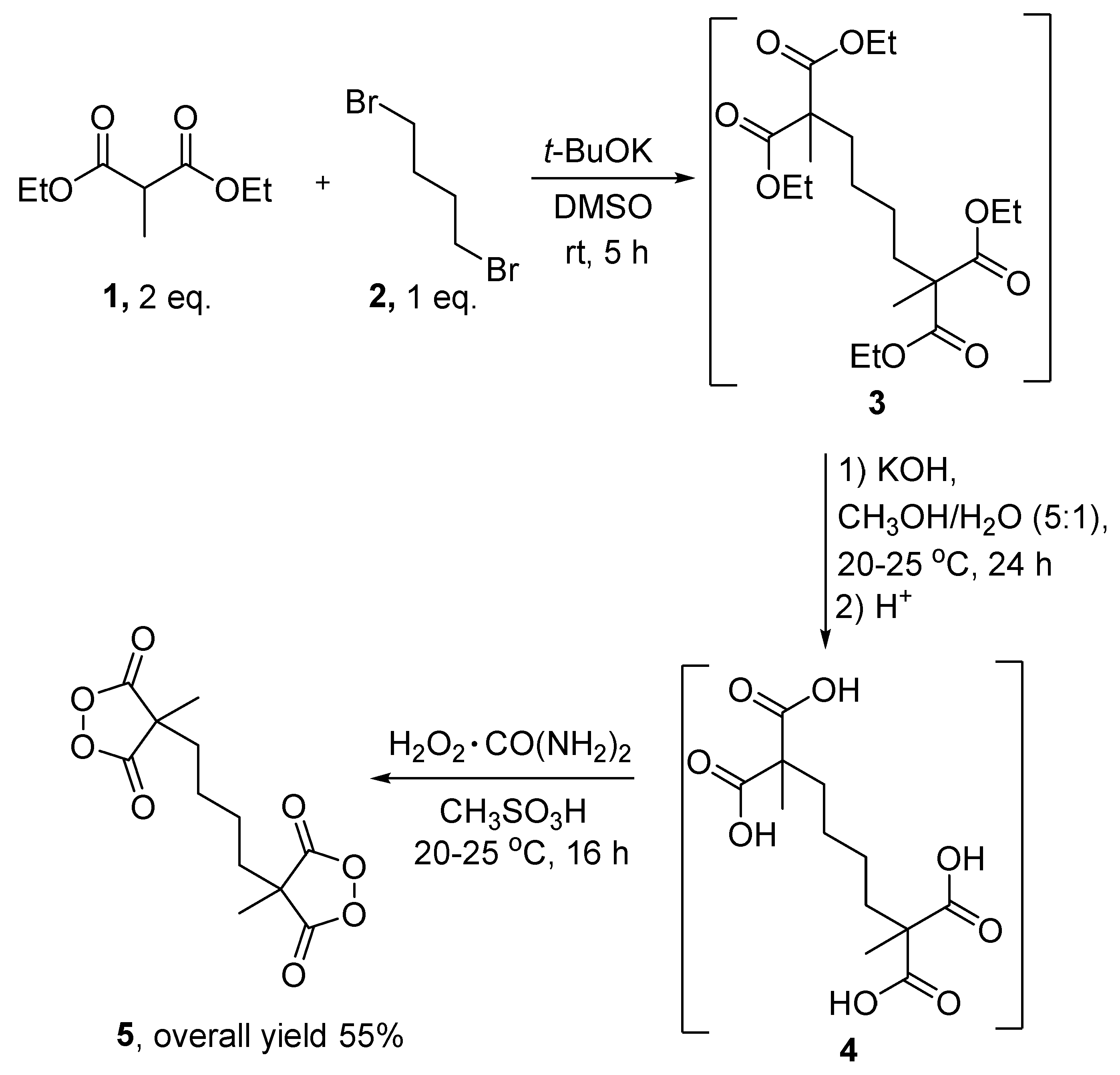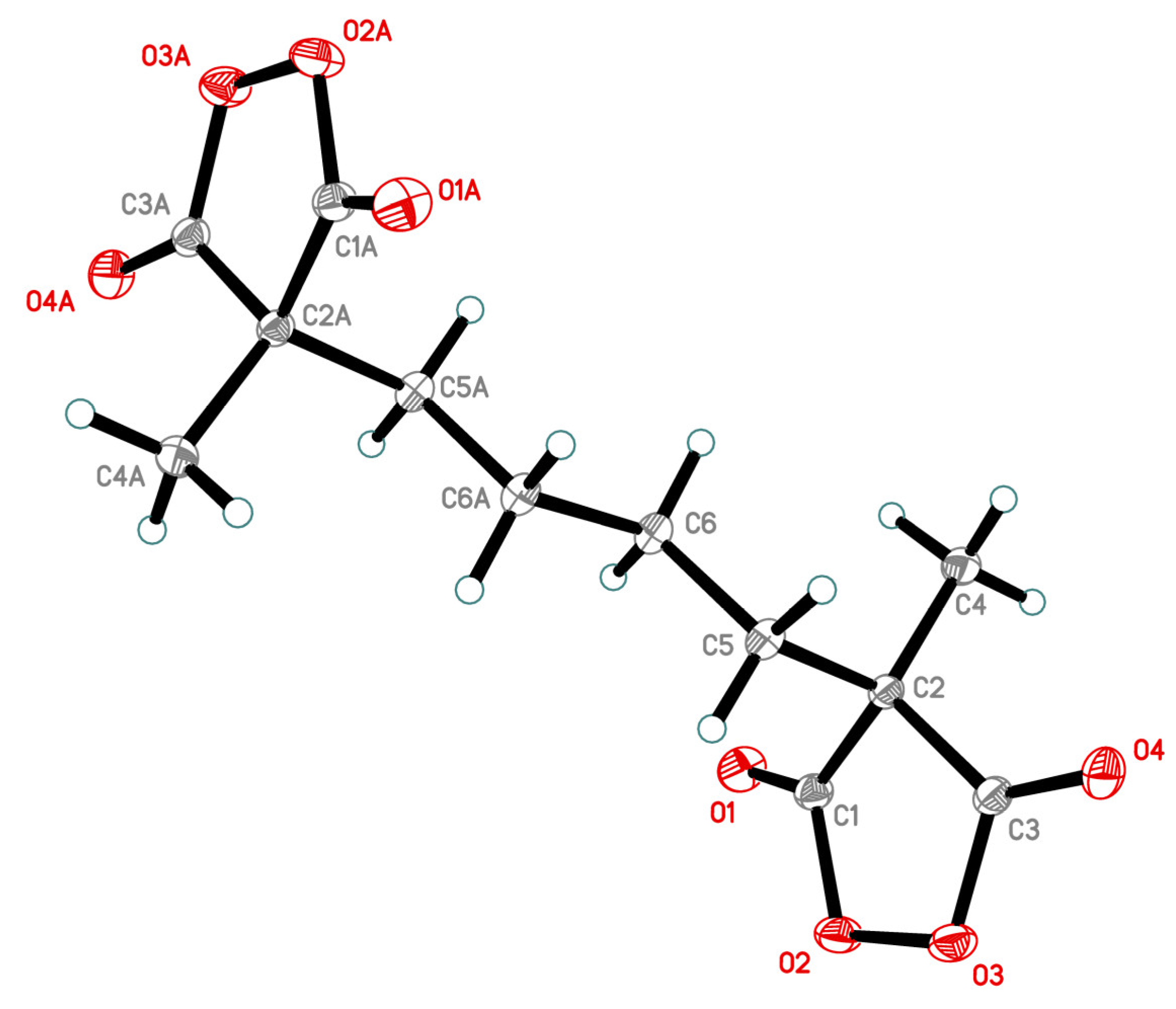4,4′-(Butane-1,4-diyl)bis(4-methyl-1,2-dioxolane-3,5-dione)
Abstract
:1. Introduction
2. Results and Discussion
3. Materials and Methods
3.1. General Information
3.2. Synthesis of Tetraethyl Octane-2,2,7,7-tetracarboxylate (3)
3.3. Synthesis of Octane-2,2,7,7-tetracarboxylic Acid (4)
3.4. Synthesis of 4,4′-(Butane-1,4-diyl)bis(4-methyl-1,2-dioxolane-3,5-dione) (5)
4. Conclusions
Supplementary Materials
Author Contributions
Funding
Institutional Review Board Statement
Informed Consent Statement
Data Availability Statement
Acknowledgments
Conflicts of Interest
References
- Greene, F.D. Cyclic diacyl peroxides. I. Monomeric phthaloyl peroxide1. J. Am. Chem. Soc. 1956, 78, 2246–2250. [Google Scholar] [CrossRef]
- Adam, W.; Rucktaeschel, R. Cyclic peroxides. V. α-Lactone intermediate via photodecarboxylation of a monomeric malonyl peroxide. J. Am. Chem. Soc. 1971, 93, 557–559. [Google Scholar] [CrossRef]
- Barsegyan, Y.A.; Vil’, V.A. Malonyl peroxides in organic synthesis (microreview). Chem. Heterocycl. Compd. 2019, 55, 1035–1037. [Google Scholar] [CrossRef]
- Zhao, R.; Chang, D.; Shi, L. Recent advances in cyclic diacyl peroxides: Reactivity and selectivity enhancement brought by the cyclic structure. Synthesis 2017, 49, 3357–3365. [Google Scholar] [CrossRef]
- Greene, F.D. Cyclic diacyl peroxides. II. Reaction of phthaloyl peroxide with cis-and trans-stilbene. J. Am. Chem. Soc. 1956, 78, 2250–2254. [Google Scholar] [CrossRef]
- Griffith, J.C.; Jones, K.M.; Picon, S.; Rawling, M.J.; Kariuki, B.M.; Campbell, M.; Tomkinson, N.C. Alkene syn dihydroxylation with malonoyl peroxides. J. Am. Chem. Soc. 2010, 132, 14409–14411. [Google Scholar] [CrossRef] [PubMed]
- Yuan, C.; Axelrod, A.; Varela, M.; Danysh, L.; Siegel, D. Synthesis and reaction of phthaloyl peroxide derivatives, potential organocatalysts for the stereospecific dihydroxylation of alkenes. Tetrahedron Lett. 2011, 52, 2540–2542. [Google Scholar] [CrossRef]
- Tomkinson, N.; Jones, K.M. Metal-free dihydroxylation of alkenes using cyclobutane malonoyl peroxide. J. Org. Chem. 2012, 77, 921–928. [Google Scholar] [CrossRef]
- Rawling, M.J.; Tomkinson, N.C. Metal-free syn-dioxygenation of alkenes. Org. Biomol. Chem. 2013, 11, 1434–1440. [Google Scholar] [CrossRef] [Green Version]
- Alamillo-Ferrer, C.; Davidson, S.C.; Rawling, M.J.; Theodoulou, N.H.; Campbell, M.; Humphreys, P.G.; Kennedy, A.R.; Tomkinson, N.C. Alkene anti-dihydroxylation with malonoyl peroxides. Org. Lett. 2015, 17, 5132–5135. [Google Scholar] [CrossRef]
- Alamillo-Ferrer, C.; Karabourniotis-Sotti, M.; Kennedy, A.R.; Campbell, M.; Tomkinson, N.C. Alkene dioxygenation with malonoyl peroxides: Synthesis of γ-lactones, isobenzofuranones, and tetrahydrofurans. Org. Lett. 2016, 18, 3102–3105. [Google Scholar] [CrossRef] [PubMed] [Green Version]
- Alamillo-Ferrer, C.; Curle, J.M.; Davidson, S.C.; Lucas, S.C.; Atkinson, S.J.; Campbell, M.; Kennedy, A.R.; Tomkinson, N.C. Alkene oxyamination using malonoyl peroxides: Preparation of pyrrolidines and isoxazolidines. J. Org. Chem. 2018, 83, 6728–6740. [Google Scholar] [CrossRef] [PubMed] [Green Version]
- Yuan, C.; Liang, Y.; Hernandez, T.; Berriochoa, A.; Houk, K.N.; Siegel, D. Metal-free oxidation of aromatic carbon-hydrogen bonds through a reverse-rebound mechanism. Nature 2013, 499, 192–196. [Google Scholar] [CrossRef]
- Camelio, A.M.; Liang, Y.; Eliasen, A.M.; Johnson, T.C.; Yuan, C.; Schuppe, A.W.; Houk, K.; Siegel, D. Computational and experimental studies of phthaloyl peroxide-mediated hydroxylation of arenes yield a more reactive derivative, 4,5-dichlorophthaloyl peroxide. J. Org. Chem. 2015, 80, 8084–8095. [Google Scholar] [CrossRef] [PubMed]
- Dragan, A.; Kubczyk, T.M.; Rowley, J.H.; Sproules, S.; Tomkinson, N.C. Arene oxidation with malonoyl peroxides. Org. Lett. 2015, 17, 2618–2621. [Google Scholar] [CrossRef] [PubMed] [Green Version]
- Li, F.-Z.; Li, S.; Zhang, P.-P.; Huang, Z.-H.; Zhang, W.-B.; Gong, J.; Yang, Z. A chiral pool approach for asymmetric syntheses of (−)-antrocin, (+)-asperolide C, and (−)-trans-ozic acid. Chem. Commun. 2016, 52, 12426–12429. [Google Scholar] [CrossRef]
- Pilevar, A.; Hosseini, A.; Šekutor, M.; Hausmann, H.; Becker, J.; Turke, K.; Schreiner, P.R. Tuning the reactivity of peroxo anhydrides for aromatic C-H bond oxidation. J. Org. Chem. 2018, 83, 10070–10079. [Google Scholar] [CrossRef]
- Song, Y.-K.; Liu, L.; Wang, J.-J.; Qian, F.; Yang, M.-Q.; Zhang, L.-Q.; Fu, J.-G.; Li, Y.-M.; Feng, C.-G. An asymmetric synthesis of (+)-scrodentoid A from dehydroabietic acid. Tetrahedron 2021, 85, 132031. [Google Scholar] [CrossRef]
- Tavakoli, A.; Dudley, G.B. Synthesis of coprinol and several alcyopterosin sesquiterpenes by regioselective [2 + 2 + 2] alkyne cyclotrimerization. J. Org. Chem. 2022, 87, 14909–14914. [Google Scholar] [CrossRef]
- Eliasen, A.M.; Christy, M.; Claussen, K.R.; Besandre, R.; Thedford, R.P.; Siegel, D. Dearomatization reactions using phthaloyl peroxide. Org. Lett. 2015, 17, 4420–4423. [Google Scholar] [CrossRef] [PubMed]
- Terent’ev, A.O.; Vil’, V.A.; Nikishin, G.I.; Adam, W. Lanthanide-catalyzed oxidative C-O coupling of 1,3-dicarbonyl compounds with diacyl peroxides. Synlett 2015, 26, 802–806. [Google Scholar] [CrossRef] [Green Version]
- Terent’ev, A.O.; Vil’, V.A.; Gorlov, E.S.; Nikishin, G.I.; Pivnitsky, K.K.; Adam, W. Lanthanide-catalyzed oxyfunctionalization of 1,3-diketones, acetoacetic esters, and malonates by oxidative C-O coupling with malonyl peroxides. J. Org. Chem. 2016, 81, 810–823. [Google Scholar] [CrossRef] [PubMed]
- Bityukov, O.V.; Vil’, V.A.; Merkulova, V.M.; Nikishin, G.I.; Terent’ev, A.O. Silica gel mediated oxidative C-O coupling of β-dicarbonyl compounds with malonyl peroxides in solvent-free conditions. Pure Appl. Chem. 2018, 90, 7–20. [Google Scholar] [CrossRef]
- Terent’ev, A.O.; Vil’, V.A.; Gorlov, E.S.; Rusina, O.N.; Korlyukov, A.A.; Nikishin, G.I.; Adam, W. Selective oxidative coupling of 3H-pyrazol-3-ones, isoxazol-5(2H)-ones, pyrazolidine-3,5-diones, and barbituric acids with malonyl peroxides: An effective C-O functionalization. ChemistrySelect 2017, 2, 3334–3341. [Google Scholar] [CrossRef]
- Vil’, V.A.; Gorlov, E.S.; Bityukov, O.V.; Barsegyan, Y.A.; Romanova, Y.E.; Merkulova, V.M.; Terent’ev, A.O. C-O coupling of malonyl peroxides with enol ethers via [5 + 2] cycloaddition: Non-rubottom oxidation. Adv. Synth. Catal. 2019, 361, 3173–3181. [Google Scholar] [CrossRef]
- Vil’, V.A.; Gorlov, E.S.; Yu, B.; Terent’ev, A.O. Oxidative α-acyloxylation of acetals with cyclic diacyl peroxides. Org. Chem. Front. 2021, 8, 3091–3101. [Google Scholar] [CrossRef]
- Vil’, V.A.; Gorlov, E.S.; Shuingalieva, D.V.; Kunitsyn, A.Y.; Krivoshchapov, N.V.; Medvedev, M.G.; Alabugin, I.V.; Terent’ev, A.O. Activation of O-electrophiles via structural and solvent effects: SN2@O reaction of cyclic diacyl peroxides with enol acetates. J. Org. Chem. 2022, 87, 13980–13989. [Google Scholar] [CrossRef]
- Alabugin, I.V.; Kuhn, L.; Medvedev, M.G.; Krivoshchapov, N.V.; Vil’, V.A.; Yaremenko, I.A.; Mehaffy, P.; Yarie, M.; Terent’ev, A.O.; Zolfigol, M.A. Stereoelectronic power of oxygen in control of chemical reactivity: The anomeric effect is not alone. Chem. Soc. Rev. 2021, 50, 10253–10345. [Google Scholar] [CrossRef]
- Singh, R.K.; Danishefsky, S. Preparation of activated cyclopropanes by phase transfer alkylation. J. Org. Chem. 1975, 40, 2969–2970. [Google Scholar] [CrossRef]
- Weiner, N. Malonic acid. Org. Synth. 1938, 18, 50. [Google Scholar] [CrossRef]
- Terent’ev, A.O.; Vil’, V.A.; Mulina, O.M.; Pivnitsky, K.K.; Nikishin, G.I. A convenient synthesis of cyclopropane malonyl peroxide. Mendeleev Commun. 2014, 24, 345. [Google Scholar] [CrossRef]
- Tsedilin, A.M.; Fakhrutdinov, A.N.; Eremin, D.B.; Zalesskiy, S.S.; Chizhov, A.O.; Kolotyrkina, N.G.; Ananikov, V.P. How sensitive and accurate are routine NMR and MS measurements? Mendeleev Commun. 2015, 25, 454–456. [Google Scholar] [CrossRef]
- Bruker AXS Inc. Bruker. APEX-III; Bruker AXS Inc.: Madison, WI, USA, 2019. [Google Scholar]
- Krause, L.S.; Herbst-Irmer, R.; Sheldrick, G.M.; Stalke, D. Comparison of silver and molybdenum microfocus X-ray sources for single-crystal structure determination. J. Appl. Crystallogr. 2015, 48, 3–10. [Google Scholar] [CrossRef] [Green Version]
- Sheldrick, G.M. SHELXT—Integrated space-group and crystal-structure determination. Acta Crystallogr. A Found. Adv. 2015, 71, 3–8. [Google Scholar] [CrossRef] [PubMed] [Green Version]
- Sheldrick, G.M. Crystal structure refinement with SHELXL. Acta Crystallogr. C Struct. Chem. 2015, 71, 3–8. [Google Scholar] [CrossRef] [PubMed] [Green Version]



Publisher’s Note: MDPI stays neutral with regard to jurisdictional claims in published maps and institutional affiliations. |
© 2022 by the authors. Licensee MDPI, Basel, Switzerland. This article is an open access article distributed under the terms and conditions of the Creative Commons Attribution (CC BY) license (https://creativecommons.org/licenses/by/4.0/).
Share and Cite
Vil’, V.A.; Gorlov, E.S.; Terent’ev, A.O. 4,4′-(Butane-1,4-diyl)bis(4-methyl-1,2-dioxolane-3,5-dione). Molbank 2022, 2022, M1497. https://doi.org/10.3390/M1497
Vil’ VA, Gorlov ES, Terent’ev AO. 4,4′-(Butane-1,4-diyl)bis(4-methyl-1,2-dioxolane-3,5-dione). Molbank. 2022; 2022(4):M1497. https://doi.org/10.3390/M1497
Chicago/Turabian StyleVil’, Vera A., Evgenii S. Gorlov, and Alexander O. Terent’ev. 2022. "4,4′-(Butane-1,4-diyl)bis(4-methyl-1,2-dioxolane-3,5-dione)" Molbank 2022, no. 4: M1497. https://doi.org/10.3390/M1497





